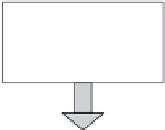Biomedical Engineering Reference
In-Depth Information
As far as the local regulation of bone cell function is concerned, after the
recent discovery of the RANK-RANKL-OPG system, we have a clearer
picture regarding the control of osteoclastogenesis and bone remodeling
in general. The main switch for osteoclastic bone resorption is the RANKL
[28], a cytokine that is released by preosteoblasts [3]. Its action on the RANK
receptor is regulated by OPG, a decoy receptor, which is also derived from
osteoblastic lineage-active osteoblasts [3]. Osteoclast-to-osteoblast cross talk
occurs mostly through growth factors, such as TGF-β, which are released
from the bone matrix during resorption. The action of TGF-β on bone cells
can be accounted for by means of activator and/or repressor functions. TGF-β
stimulates differentiation of uncommitted osteoblast precursor cells (OBU),
but it inhibits differentiation of osteoblast precursor cells (OBP) [3]. Thus, the
action of TGF-β on osteoblastic cells leads to an increase of the pool of osteo-
blast precursor cells, as shown in Figure 7.1. If TGF-β is removed from the
system or becomes inactivated, osteoblast precursor cells can differentiate to
become active osteoblastic cells (OBA). On the other hand, TGF-β has been
found to promote osteoclast apoptosis [29].
The RANK-RANKL-OPG signaling pathway between osteoblasts and
osteoclasts, PTH and the dual action of TGF-β is diagrammed in Figure 7.1.
Given the large number of different cell types involved in active bone-cell
differentiation, only a representative subset of cell types is included in the
model described in this chapter. As a minimalist realistic approximation,
four cell types of the osteoblast lineage (with two being state variables) and
Uncommitted
osteoblastic
progenitors (OBU)
Apototic
osteoclasts
TGF- β(+)
PTH(+)
TGF- β(+)
Active
osteoclasts
(OCA)
Preosteoblasts
(OBP)
RANKL(+)
RANK(+)
TGF- β(-)
PTH(+)
Osteoclast
precursors
(OCP)
Mature
osteoblasts
(OBA)
OPG(-)
Apoptotic
osteoblasts
and osteocytes
Hematopoietic
stem cells
FIGURE 7.1
Illustration of bone cell model including the RANK-RANKL-OPG signaling pathway, PTH,
and dual action of TGF-β. A (+) or (-) beside a factor represents stimulatory or inhibitory action
by the factor.















